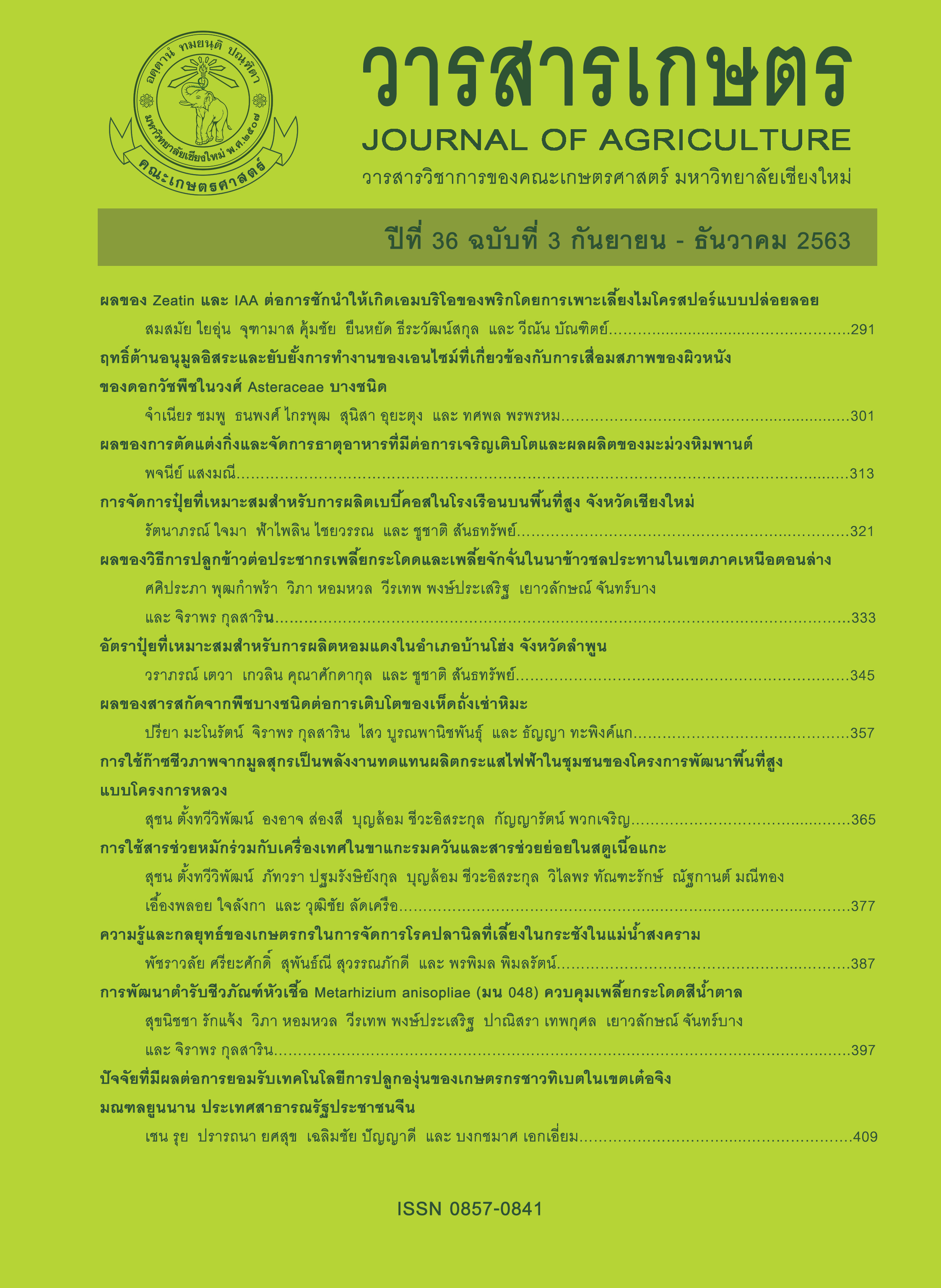ผลของ Zeatin และ IAA ต่อการชักนำให้เกิดเอมบริโอของพริก โดยการเพาะเลี้ยงไมโครสปอร์แบบปล่อยลอย
Main Article Content
บทคัดย่อ
ผลของ zeatin และ IAA ต่อการชักนำให้เกิดเอมบริโอโดยการเพาะเลี้ยงไมโครสปอร์แบบปล่อยลอยดำเนินการในพริกสายพันธุ์ 17212 โดยใช้อับเรณูที่ส่วนปลายมีสีม่วง 10% ซึ่งมีไมโครสปอร์ในระยะระหว่าง mid และ uninucleate การเติมสารควบคุมการเจริญเติบโตในอาหารเพาะเลี้ยงแบบ 2 ชั้น คือ zeatin 0.0, 0.1, 0.5 และ 1 มิลลิกรัมต่อลิตร ร่วมกับ IAA 0.0, 0.5, 0.8 และ 1.8 มิลลิกรัมต่อลิตร พบว่า zeatin 0.1 มิลลิกรัมต่อลิตร ร่วมกับ IAA เข้มข้น 0.5 มิลลิกรัมต่อลิตร ชักนำให้เกิดเอมบริโอสูงสุดอย่างมีนัยสำคัญ 40.8% และพัฒนาเป็นต้นได้ 35.9% นอกจากนี้การตรวจสอบชุดโครโมโซมด้วยวิธีโฟลไซโทเมทรีในต้นที่พัฒนาจากการเพาะเลี้ยงไมโครสปอร์ พบว่า เป็นแฮพลอยด์ 62% และดับเบิลแฮพลอยด์ 38% ดังนั้นการเพาะเลี้ยงไมโครสปอร์แบบปล่อยลอยสามารถใช้ในการสร้างพริกดับเบิลแฮพลอยด์ได้อย่างมีประสิทธิภาพ
Article Details
เอกสารอ้างอิง
Dumas de Vaulx, R., D. Chambonnet and E. Pochard. 1981. In vitro of pepper (Capsicum annuum L.) anthers: High rate plant production from different genotypes by +35 °C treatments. Agronomie 1(10): 859-864.
Galbraith, D.W., K.R. Harkins, J.M. Maddox, N.M. Ayres, D.P. Sharma and E. Firoozabady. 1983. Rapid flow cytometric analysis of the cell cycle in intact plant tissues. Science 220(4601): 1049-1051.
Gemesne, J., A.M. Petus, G. Venczel, L. Zatyko, G. Gyulai and M. Cseplo. 2001. Genetic variability of anther donor versus spontaneous doubled haploid descendants and colchicine induced doubled haploid sweet pepper (Capsicum annuum L.) lines. Acta Horticulturae 560: 149-152.
Gyulai, G., J.A. Gemesne, Z. Sagi, G. Venczel, P. Pinter, Z. Kristof, O. Torjek, L. Heszky, S. Bottka, J. Kiss and L. Zatyko. 2000. Doubled haploid development and PCR-analysis of F1 hybrid derived DH-R2 paprika (Capsicum annuum L.) lines. Journal of Plant Physiology 156(2): 168-174.
Johansson, L., B. Andersson and T. Eriksson. 1982. Improvement of anther culture technique: activated charcoal bound in agar medium in combination with liquid medium and elevated CO2 concentration. Physiologia Plantarum 54(1): 24-30.
Kaveeta, R. 1998. Tissue Culture. Kasetsart University Press, Bangkok. 219 p. (in Thai)
Kim, M.Z. and I.C. Jang. 2000. Rapid assessment of microspore development stage in pepper using DAPI and ferric chloride. Journal of Plant Biotechnology 2(3): 129-134.
Nitsch, J.P. and C. Nitsch. 1969. Haploid plants from pollen grain. Science 163(3862): 85-87.
Nowaczyk, P. and A. Kisiala. 2006. Effect of selected factors on the effectiveness of Capsicum annuum L. anther culture. Journal of Applied Genetics 47(2): 113-117.
Rasmeethamwong, P. 1995. How to Grow and Propagate Pepper. 3rd ed. Petchkarat Publishing, Bangkok. 104 p. (in Thai)
Smitamana, P. 1999. Plant Tissue Culture: Technique and Application. Faculty of Agriculture, Chiang Mai University, Chiang Mai. 141 p. (in Thai)
Supena, E.D.J., S. Suharsono., E. Jacobsen and J.B.M. Clusters. 2006. Successful development of a shed-microspore culture protocol for doubled haploid production in Indonesian hot pepper (Capsicum annuum L.). Plant Cell Reports 25(1): 1-10.
Techawongstien, S. 1994. Pepper Breeding and Production. Ministry of Agriculture and Cooperatives, Bangkok. 57 p. (in Thai)
Zhang, Y.L., L.G. Zhang, H.M. Zhang and L.Z. Zhang. 2009. Studies on embryoid induction of isolated microspore and plantlet formation in precocious chinese cabbage. Journal of Gansu Agricultural University 44(3): 45-49.


